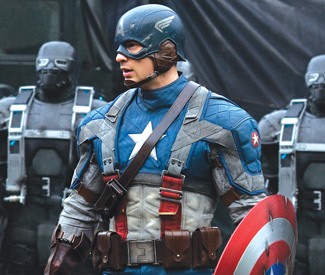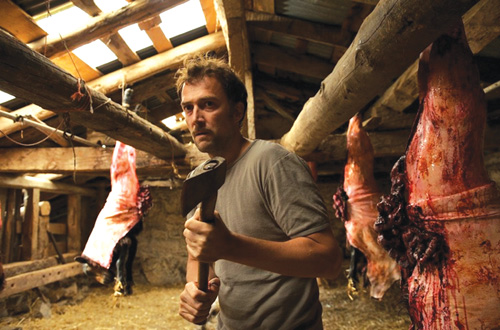DENNIS HARVEY’S FAVORITE DOCUMENTARIES OF 2011:
American Teacher (Vanessa Roth and Brian McGinn, U.S.)
The Arbor (Clio Barnard, U.K.)
Buck (Cindy Meehl, U.S.)
The Last Lions (Dereck Joubert, U.S./Botswana)
My Perestroika (Robin Hessman, U.S./U.K./Russia)
Nostalgia for the Light (Patricio Guzmán, France/Germany/Chile)
Pianomania (Robert Cibis and Lilian Franck, Austria/Germany)
Pina (Wim Wenders, Germany/France/U.K.)
Shut Up Little Man! An Audio Misadventure (Matthew Bate, Australia)
Vigilante Vigilante: The Battle for Expression (Max Good, U.S.)
We Were Here (David Weissman and Bill Weber, U.S.)
DENNIS HARVEY’S FAVORITE NARRATIVE FEATURES OF 2011:
The Artist (Michel Hazanavicius, France/Belgium)
Ceremony (Max Winkler, U.S.)
Certified Copy (Abbas Kiarostami, France/Italy/Belgium)
The Descendants (Alexander Payne, U.S.)
Drive (Nicolas Winding Refn, U.S.)
Happy, Happy (Anne Sewitsky, Norway)
Hugo (Martin Scorsese, U.S.)
I’m Glad My Mother Is Alive (Claude Miller and Nathan Miller, France)
Incendies (Denis Villeneuve, Canada/France)
Machotaildrop (Corey Adams and Alex Craig, U.S./Canada)
The Mill and the Cross (Lech Majewski, Sweden/Poland)
The Names of Love (Michel Leclerc, France)
Oka! (Lavinia Currier, U.S.)
Rango (Gore Verbinski, U.S.)
A Separation (Asghar Farhadi, Iran)
The Strange Case of Angelica (Manoel de Oliveira, Portugal/Spain/France/Brazil)
Tucker and Dale vs. Evil (Eli Craig, U.S./Canada)
Uncle Boonmee Who Can Recall His Past Lives (Apichatpong Weerasethakul, Thailand/U.K./France/Germany/Spain/Netherlands)
Weekend (Andrew Haigh, U.K.)
Young Adult (Jason Reitman, U.S.)
CHERYL EDDY’S TOP 11 OF 2011
1. The Artist (Michel Hazanavicius, France/Belgium)
2. Young Adult (Jason Reitman, U.S.)
3. Tinker Tailor Soldier Spy (Tomas Alfredson, France/U.K./Germany)
4. Drive (Nicolas Winding Refn, U.S.)
5. Melancholia (Lars von Trier, Denmark/Sweden/France/Germany)
6. The Descendants (Alexander Payne, U.S.)
7. Shame (Steve McQueen, U.K.)
8. The Trip (Michael Winterbottom, U.K.)
9. Cave of Forgotten Dreams (Werner Herzog, Canada/U.S./France/Germany/U.K.)
10. TrollHunter (André Øvredal, Norway)
11. The Tree of Life (Terrence Malick, U.S.)
KIMBERLY CHUN’S TOP 10 FILM “LIKES” OF 2011
(ALPHABETICAL)
Please don’t speak: The Artist (Michel Hazanavicius, France/Belgium)
Scrappy apocalypse: Attack the Block (Joe Cornish, U.K./France)
Scraps of footage refashioned: The Black Power Mixtape 1967-1975 (Goran Olsson, Sweden)
Best long-form music video: Drive (Nicolas Winding Refn, U.S.)
Personal apocalypse: The Future (Miranda July, Germany/U.S.)
The lives of others: Margin Call (J.C. Chandor, U.S.)
Feel-good apocalypse: Melancholia (Lars von Trier,
Denmark/Sweden/France/Germany)
Body Con: Shame (Steve McQueen, U.K.)
Body Con 2: The Skin I Live In (Pedro Almodóvar, Spain)
Two-state evolution: The Time That Remains (Elia Suleiman, U.K./Italy/Belgium/France)
RYAN LATTANZIO’S TOP 11 OF 2011
1. Melancholia (Lars von Trier, Denmark/Sweden/France/Germany)
2. Uncle Boonmee Who Can Recall His Past Lives (Apichatpong Weerasethakul, Thailand/U.K./France/Germany/Spain/Netherlands)
3. We Need to Talk About Kevin (Lynne Ramsay, U.K./U.S.)
4. Drive (Nicolas Winding Refn, U.S.)
5. Certified Copy (Abbas Kiarostami, France/Italy/Belgium)
6. A Separation (Asghar Farhadi, Iran)
7. Into the Abyss: A Tale of Death, a Tale of Life (Werner Herzog, Germany/Canada)
8. Weekend (Andrew Haigh, U.K.)
9. Shame (Steve McQueen, U.K.)
10. Meek’s Cutoff (Kelly Reichardt, U.S.)
11. The Future (Miranda July, Germany/U.S.)
JESSE HAWTHORNE FICKS’ PICKS FOR 2011
(FOLLOWED BY THE AMOUNT OF TIMES HE’S SEEN EACH FILM, IF MORE THAN ONCE)
(Updated from the print version)
1. (tie) Meek’s Cutoff (Kelly Reichardt, U.S.)
Even though this was on my list last year, it was released officially this year. Minimalist, transcendental, and more dramatic than any other action film this year. (4)
1. (tie) Attack the Block (Joe Cornish, U.K./France)
Subversive, prophetic, and totally addictive! This is one best films of the decade! Believe, bruv! (6)
2. Midnight in Paris (Woody Allen, Spain/U.S.)
Just because this is a crowd pleaser should not detract from Allen’s complicated script, shining as bright as ever. Re-watch and be stunned that the ending is much more profound than you may have first noticed. (7)
3. Season two of Louie (FX Network)
Louis C.K. transcended his own brilliant comedy and created 13 genuine existential classics.
4. The Trip (Michael Winterbottom, U.K.)
Steve Coogan finally achieved his art house goal with this pitch-perfect exploration of a man and his own worst enemy. Winterbottom’s six-part mini-series for British television was great, but the edited-down feature film is downright life affirming. (5)
5. We Need to Talk About Kevin (Lynne Ramsay, U.K./U.S.)
Director Ramsay (our modern-day Orson Welles, anyone?) and editor Joe Bini have created an hypnotic ride of poetic cinema. Do we really have to wait 10 more years before her Ramsay’s next show stopper, like we did after 2002’s Morvern Callar?
6. (tie) Hanna (Joe Wright, U.S./U.K./Germany)
A flawless reworking of La Femme Nikita (1991) with crisp dialogue that was light years ahead of anything else this year.
6. (tie) The Woman (Lucky McKee, U.S.)
Audiences were running for the doors at Sundance. This high-concept allegory is one of the most disturbing explorations of misogyny ever put on film. (3)
6. (tie) Sucker Punch (Zack Snyder, U.S./Canada)
This fast and furious pseudo-“feminist” flick seemed to be unfairly treated and totally misunderstood by audiences and critics alike. Get the 127-minute director’s cut on Blu-ray, stop letting fanboy nonsense bully you, and revel in Emily Browning’s tour de force performance. (2)
7. Young Adult (Jason Reitman, U.S.)
Diablo Cody’s script is near-perfect in this look at a 37-year-old who has to reassess where her “determination” has led her. (2)
8. Beginners (Mike Mills, U.S.)
Who wants their heart broken? A man confronts the death of his father and realizes his romantic choices might be leading him to no man’s land. Gulp. (3)
9. Heartbeats (Xavier Dolan, Canada)
This 22-year-old writer-director-star’s mash-up of My Own Private Idaho (1991) and In the Mood for Love (1999) captures our era’s hipster insecurities so flawlessly that it’ll take a decade for people to recognize how important this film actually is. (3)
10. The Artist (Michel Hazanavicius, France/Belgium)
This accessible masterpiece proves silent movies are futuristic! Perfect for the whole family and part of the second Golden Age for cinema from the 1920s.
11. The Beaver (Jodie Foster, U.S./United Arab Emirates)
I don’t care what he does offscreen, Mel Gibson is a damn fine actor! And Jodie Foster’s dark and deeply personal directing deserves the mensch of the year award!
12. (tie) Take Shelter (Jeff Nichols, U.S.)
Michael Shannon’s performance (as a father who will stop at nothing to “protect” his family) is creepy. Nichols’ ending is even creepier.
12. (tie) Melancholia (Lars von Trier, Denmark/Sweden/France/Germany)
Von Trier’s “nicest” film is genuine therapy for a neurotic soul.
13. One Day (Lone Scherfig, U.S./U.K.)
Stop telling me the book was so much better! With a Same Time, Next Year (1978) structure, this film’s deep emotions (courtesy of Anne Hathaway) shook me to the core.
14. Certified Copy (Abbas Kiarostami, France/Italy/Belgium)
This unofficial remake of Roberto Rossellini’s Journey to Italy (1954) still kept me guessing; it also features another jaw-dropping performance by Juliette Binoche.
15. The Tree of Life (Terrence Malick, U.S.)
This audacious exploration of a 1950s family is absolutely universal and profound. (2)
16. Tyrannosaur (Paddy Considine, U.K.)
Who wants their stomach punched, ripped open, torn out, and then presented to you? Then check out this love story.
17. (tie) Hugo (Martin Scorsese, U.S.)
Who says 3D isn’t art? Did studios really allow Scorsese to show multiple Georges Méliès’ films in 3D? Plus, Sacha Baron Cohen gives a truly Oscar-worthy supporting performance.
17. (tie) Drive Angry (Patrick Lussier, U.S.)
Lussier, director of 2009’s absolutely brilliant My Bloody Valentine remake, facilitated a priceless Nicolas Cage performance — he drinks from a freakin’ human skull, in 3D — but keeps things so frenetic, I had to sit in the theater for a second viewing as soon as it was over! (2)
17. (tie) Final Destination 5 (Steven Quale, U.S.)
In which the entire franchise of entitled 20-somethings dying gruesome deaths comes full circle by concluding with every single grisly death from all five films in glorious 3D.
18. The Mill and the Cross (Lech Majewski, Sweden/Poland)
Rutger Hauer + 143 Digital layers = monumental experimental art for the ages!
19. Rakhta Charitra and Rakhta Charitra 2 (Ram Gopal Varma, India)
Ram Gopal Varma’s films should compete at Cannes. (2)
20. Bill Cunningham New York (Richard Press, U.S./France)
This doc’s inspiring message: do what you love every day of your life, and don’t ever slow down.
Actor of the Year: Andy Serkis (Rise of the Planet of the Apes, The Adventures of Tintin)
Actress of the Year: Melissa McCarthy (Bridesmaids)
Best Future Midnite Movie: The Catechism Cataclysm (Todd Rohal, U.S.)
Shot in less than a week, this abstract, train of thought buddy road trip has the immediacy of sheer brilliance!
Jesse Hawthorne Ficks teaches film history at the Academy of Art University and curates and hosts Midnites for Maniacs, a film series emphasizing dismissed, underrated, and overlooked films.
LYNN RAPOPORT’S TOP 8 FILMS OF 2011
1. The Artist (Michel Hazanavicius, France/Belgium)
2. Beginners (Mike Mills, U.S.)
3. Tomboy (Céline Sciamma, France)
4. Dirty Girl (Abe Sylvia, U.S.)
5. Bridesmaids (Paul Feig, U.S.)
6. Pariah (Dee Rees, U.S.)
7. Young Adult (Jason Reitman, U.S.)
8. Crazy, Stupid, Love. (Glenn Ficarra and John Requa, U.S.)
SAM STANDER’S TOP 10 FILMS OF 2011
1. Uncle Boonmee Who Can Recall His Past Lives (Apichatpong Weerasethakul, Thailand/U.K./France/Germany/Spain/Netherlands)
2. Meek’s Cutoff (Kelly Reichardt, U.S.)
3. Drive (Nicolas Winding Refn, U.S.)
4. Midnight in Paris (Woody Allen, Spain/U.S.)
5. Certified Copy (Abbas Kiarostami, France/Italy/Belgium)
6. The Tree of Life (Terrence Malick, U.S.)
7. Essential Killing (Jerzy Skolimowski, Poland/Norway/Iceland/Hungary)
8. The Future (Miranda July, U.S.)
9. Bridesmaids (Paul Feig, U.S.)
10. Captain America: The First Avenger (Joe Johnston, U.S.)
MAX GOLDBERG’S TOP 10 FILMS OF 2011 (SAN FRANCISCO OPENINGS)
The Arbor (Clio Barnard, U.K.)
Attenberg (Athina Rachel Tsangari, Greece)
Get Out of the Car (Thom Andersen, U.S.)
The Kid with a Bike (Jean-Pierre Dardenne and Luc Dardenne, Belgium/France/Italy)
Mysteries of Lisbon (Raúl Ruiz, Portugal)
Of Gods and Men (Xavier Beauvois, France)
Oki’s Movie (Hong Sang-soo, South Korea)
Road to Nowhere (Monte Hellman, U.S.)
Terri (Azazel Jacobs, U.S.)
Señora con Flores/ Woman with Flowers (Chick Strand, U.S./Mexico)
























